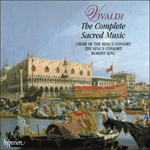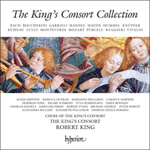
Welcome to Hyperion Records, a British classical label devoted to presenting high-quality recordings of music of all styles and from all periods from the twelfth century to the twenty-first.
Hyperion offers both CDs, and downloads in a number of formats. The site is also available in several languages.
Please use the dropdown buttons to set your preferred options, or use the checkbox to accept the defaults.

RV589 typifies what the Pietà understood as a concertato setting of a long liturgical text. Each sentence or comparable unit generates a separate musical movement, and the movements are differentiated among themselves to the maximum extent in scoring, tonality, metre, tempo, style, texture and mood. Some movements employ solo voices, alone or in small groups, while others (in particular, the movements framing the work) employ choir. Rather exceptionally for Vivaldi, one movement of the present Gloria, the ‘Domine Deus, agnus Dei’, features both a solo singer (mezzo soprano) and the choir, which are treated in responsorial style. Generally speaking, however, Vivaldi and his north Italian contemporaries liked to segregate solo and choral singing in separate movements.
The rousing opening movement, ‘Gloria in excelsis Deo’, is not mere ‘noise and thunder’; in the middle of it Vivaldi embarks on a bold tonal excursion that takes him as far as C sharp minor, a key rather remote from the initial D major. But how deftly the composer finds his way back to the tonic! Sophisticated handling of key change rises to new heights in the long, complex and emotionally harrowing second movement, ‘Et in terra pax’. What Vivaldi expresses here is not peace already achieved but peace desperately sought amid the troubles of the world. This would be the movement with which to convince a sceptic that, for all his outward wordliness, the composer was at heart – if only via music – a deeply spiritual person. Incredibly, Vivaldi originally ended this B minor movement with a major chord (a tierce de Picardie), before very wisely thinking better of the idea.
There follow a delightful duet for sopranos (‘Laudamus te’), a sombre chorus in the stile antico (‘Gratias agimus tibi’), the ‘Domine Deus, rex coelestis’ mentioned earlier, a captivating chorus in dotted, or ‘French’, rhythm (‘Domine Fili unigenite’), a pensive dialogue for contralto and chorus (‘Domine Deus, agnus Dei’), another sombre chorus (‘Qui tollis’), and a ‘church aria’ for contralto (‘Qui sedes’) heralding the return of the opening material. This duly arrives in the ‘Quoniam’ chorus, which is a simplified (non-modulating) version of the opening movement. The scene is set for the final fugue, which (as in RV588) is an adaptation of its counterpart in a Gloria dated 1708 by Giovanni Maria Ruggieri, of which more later.
from notes by Michael Talbot © 2004
RV589 est typique de ce que la Pietà entendait par arrangement concertato d’un long texte liturgique. Chaque phrase ou unité comparable entraîne un mouvement musical distinct, et les mouvements se différencient les uns des autres en termes d’arrangement, tonalité, mesure, tempo, style, texture et humeur. Certains mouvements ont recours aux voix de solistes, seules ou en petits groupes, tandis que d’autres emploient le chœur. Fait exceptionnel pour Vivaldi, un des mouvements du présent Gloria, le Domine Deus, agnus Dei met en scène à la fois une soliste (mezzo soprano) et le chœur, à la manière d’un répons. En règle générale, toutefois, Vivaldi et ses contemporains d’Italie du Nord aimaient séparer les solistes et le chœur en leur donnant des mouvements différents.
Le mouvement entraînant d’ouverture, Gloria in excelsis Deo n’est pas que « bruit et tonnerre » ; en son milieu, Vivaldi se lance dans une excursion tonale audacieuse qui l’emmène jusqu’en do dièse mineur, tonalité pour le moins lointaine du ré majeur de départ. Mais avec quelle dextérité le compositeur retombe-t-il sur la tonique ! Le maniement sophistiqué des changements de ton déploie une maîtrise supérieure dans le second mouvement, long, complexe et très émouvant, Et in terra pax. Ici, Vivaldi n’exprime pas seulement la paix retrouvée, mais la paix recherchée désespérément au sein d’un monde en proie aux tourments. Parmi tous les mouvements, celui-ci devrait convaincre les sceptiques que malgré sa mondanité apparente, le compositeur était vraiment (si ce n’est que par la musique) un homme profondément spirituel. Chose incroyable, à l’origine, Vivaldi termina ce mouvement en si mineur par un accord majeur (une « tierce de Picardie »), avant d’adopter la voix de la sagesse et réviser cette idée initiale.
Il s’en suit un très beau duo aux sopranos (Laudamus te), un chœur sombre dans le stile antico (Gratias agimus tibi), le Domine Deus, rex coelestis mentionné plus haut, un chœur captivant en notes pointées, ou « rythme français » (Domine Fili unigenite), un dialogue méditatif pour mezzo et chœur (Domine Deus, agnus Dei), un autre chœur sombre (Qui tollis), et un aria pour mezzo soprano (Qui sedes) annonçant le retour du thème d’ouverture. Ce retour se produit dans le chœur Quoniam, version simplifiée (non modulée) du mouvement d’ouverture. Le final est une fugue constituée, à l’instar de RV588, par une adaptation de sa contrepartie, un Gloria daté de 1708 par Giovanni Maria Ruggieri.
extrait des notes rédigées par Michael Talbot © 2004
Français: Marie Luccheta
In RV589 wird dargestellt, was man an der Pietà unter einer Concertato-Vertonung eines langen liturgischen Texts verstand. Aus jedem Satz oder vergleichbarer Spracheinheit entsteht ein einzelner musikalischer Satz und diese Sätze unterscheiden sich in Anlage, Tonalität, Metrum, Tempo, Stil, Textur und Stimmung so weit wie möglich voneinander. In manchen Sätzen werden Solostimmen eingesetzt, allein oder in kleinen Gruppen, während in anderen (besonders in den Randsätzen des Werks) ein Chor vorgesehen ist. Ein Satz des vorliegenden Gloria, das „Domine Deus, agnus Dei“, ist, was bei Vivaldi relativ ungewöhnlich ist, für eine Solostimme (Alt) und Chor angelegt, die responsorisch behandelt werden. Im allgemeinen verteilten Vivaldi und seine norditalienischen Zeitgenossen jedoch den solistischen und den Chorgesang auf verschiedene Sätze.
Der mitreißende erste Satz, „Gloria in excelsis Deo“, besteht nicht nur aus „donnerndem Getöse“: in der Mitte unternimmt Vivaldi einen gewagten harmonischen Ausflug, der ihn bis nach cis-Moll führt – ein weiter Weg von dem ursprünglichen D-Dur. Wie geschickt der Komponist dann aber zur Tonika zurückfindet! Die raffinierte Technik der Tonartenwechsel erreicht in dem langen, komplexen und erschütternden zweiten Satz, „Et in terra pax“, ganz neue Höhen. Was Vivaldi hier zum Ausdruck bringt, ist nicht etwa bereits erreichter Frieden, sondern ein Frieden, der inmitten der Trübsale der Welt dringend ersehnt wird. Dieser Satz könnte Skeptikern als Beweis dienen, dass Vivaldi trotz seiner äußeren Weltlichkeit doch in seinem Herzen – wenn auch nur über die Musik – ein zutiefst religiöser Mensch war. Es scheint unglaublich, dass Vivaldi diesen Satz in h-Moll ursprünglich mit einem Durakkord (einer Pikardischen Terz) enden ließ, bevor er sich eines Besseren besann.
Es folgen ein entzückendes Duett für Sopranstimmen („Laudamus te“), ein düsterer Chor im Stile antico („Gratias agimus tibi), das obengenannte „Domine Deus, rex coelestis“, ein packender Chor im punktierten oder „französischen“ Rhythmus („Domine Fili unigenite“), ein nachdenklicher Dialog zwischen Alt und Chor („Domine Deus, agnus Dei“), ein weiterer düsterer Chor („Qui tollis“) und eine „Kirchenarie“ für Altstimme („Qui sedes“), die die Rückkehr des Anfangsmaterials ankündigt. Dies erscheint wie erwartet im „Quoniam“-Chor, eine vereinfachte (nicht modulierende) Version des ersten Satzes. Darauf steht der Abschlussfuge nichts mehr in Wege, die (wie in RV588) eine Bearbeitung ihres Pendants eines Gloria aus dem Jahre 1708 von Giovanni Maria Ruggieri ist, doch darüber später mehr.
aus dem Begleittext von Michael Talbot © 2004
Deutsch: Viola Scheffel
 Vivaldi: The Complete Sacred Music Vivaldi: The Complete Sacred Music‘For King's sterling service to the Vivaldian cause, one of his most important recording and satisfying projects to date, I am thankful’ (Gramophone) ‘If you're waiting for the perfect collection of Vivaldi's sacred music, this is it. It was a happy day when this beautiful boxed set arrived in my m ...» More |
 The King's Consort Collection The King's Consort Collection'An uplifting disc, and nicely presented—I can certainly recommend this as an example of both fine music and exquisite performances' (MusicWeb Interna ...» More |

